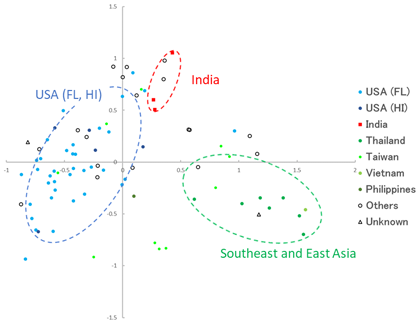Genetic diversity and characteristics of mango genetic resources in Japan
Description
Mango (Mangifera indica L.) is one of the major tropical fruits produced and consumed in Japan. Commercial production of mango in the country started in the 1980s mainly in the southwestern region, and substantially by monoculture of the ‘Irwin’ variety (occupies >90% of production in Japan). Recently, attention has been focused on mango as one of the potential crops for climate change adjustment, and as a premium fruit that can be sold at a high price in commercial markets in Japan. To promote the use of underutilized genetic resources for breeding and/or direct domestic production, assessment of genetic diversity is essential. In this study, we analyzed 120 mango genetic resources conserved at JIRCAS and Okinawa Prefectural Agricultural Research Center, covering almost all mango cultivars in Japan using 46 polymorphic simple sequence repeat (SSR) markers for cultivar identification, genetic relatedness, and genetic diversity.
The 120 mango accessions examined in this study were clearly distinguished into 83 genotypes (cultivars) excluding synonymous and identical accessions by the SSR markers. These 83 cultivars were considered to be representative mango genetic resources possessed in Japan taking their introduction background into account.
Principal coordinate analysis (PCoA), one of the multivariate analyses based on SSR data, indicated that accessions from India had a close relationship with accessions from the USA, while accessions from Thailand, Taiwan, Philippines, and Vietnam seemed to be genetically separate (Fig. 1). These groupings appear to correspond to the previously defined Indian and Southeast Asian types, and suggest that the Florida accessions, which originated from hybrids between those two types, are more closely related to the Indian type.
The accessions that we examined cover almost all mango cultivars in Japan, therefore their genetic information will pave the way to the use of genetic resources for breeding and/or direct domestic production in Japan. In addition, the accessions used in this study, mainly selected and established in Florida, USA, and disseminated to major production countries/areas, have been considered, reflecting the genetic diversity as representative of major cultivars in the world. Therefore, the SSR marker and genotype information in this study are possibly useful for assessing genetic diversity in other countries and areas of mango production.
Information on variety characteristics of 62 cultivars conserved with successful flowering and bearing fruits at JIRCAS-TARF (Ishigaki, Okinawa) were summarized and published on the website titled “JIRCAS Mango Genetic Resources Site” (https://www.jircas.go.jp/ja/database/mango/mango-top) (Fig. 2). This website describes the diversity of mango varieties and characteristics such as flowering period, harvesting time, and fruit quality using the data obtained during the 2010-2011 cultivation period at JIRCAS-TARF.
Figure, table
-
Fig. 1. A scatter plot showing the result of PCoA based on SSR marker analysis for 83 accessions of mango genetic resources in Japan. Three groups based on the origins were found (dotted circles).
-
Fig. 2. Mango genetic resources conserved at JIRCAS (left), a screenshot of the top page of the “JIRCAS Mango Genetic Resources Site” (center), and a linked page on the website, showing important information on mango variety characteristics (right).
- Affiliation
-
Japan International Research Center for Agricultural Sciences Tropical Agriculture Research Front
- Classification
-
Technical A
- Program name
- Term of research
-
FY2019 (FY2011-FY2020)
- Responsible researcher
-
Yamanaka Shinsuke ( Tropical Agriculture Research Front )
MIERUKA ID: 001785Ogata Tatsushi ( Tropical Agriculture Research Front )
MIERUKA ID: 001788Takagi Hiroko ( Tropical Agriculture Research Front )
Kozai Naoko ( Kagoshima University )
Matsumura Masato ( Okinawa Prefectural Agricultural Research Center )
Onoue-Makishi Yuko ( Okinawa Prefectural Agricultural Research Center )
Urasaki Naoya ( Okinawa Prefectural Agricultural Research Center )
KAKEN Researcher No.: 20504591Shoda Moriyuki ( Okinawa Prefectural Agricultural Research Center )
KAKEN Researcher No.: 20504591Nashima Kenji ( Nihon University )
KAKEN Researcher No.: 30779616Hosaka Fumiko ( National Agriculture and Food Research Organization (NARO) )
Yamamoto Toshiya ( National Agriculture and Food Research Organization (NARO) )
- ほか
- Publication, etc.
-
Yamanaka S et al. (2019) Breeding Science, 69:332-344
JIRCAS Mango Genetic Resources Site https://www.jircas.go.jp/ja/database/mango/mango-top
- Japanese PDF
-
2019_D02_A4_ja.pdf842.04 KB
2019_D02_A3_ja.pdf237.42 KB
- English PDF
-
2019_D02_A4_en.pdf194.3 KB
2019_D02_A3_en.pdf232.82 KB
- Poster PDF
-
2019_D02_poster_fin.pdf315.95 KB


